Concrete countertops that you can pour, set and stain yourself. Yep, it’s a real thing! In this brief but highly informative (and beautiful-picture-filled) guide, you’ll find all you need to bring a concrete countertop to life in your kitchen. Lovely marbled stone patterns, veins, colorful quartz flecks or just a brightly colored countertop to liven up your monochrome cabinets – it’s all possible with concrete.
Oh, and don’t stop there! We’ve only had time to cover kitchen countertops, but you could use this material all over your house. Concrete bathrooms are another exciting prospect; water resistant, very durable and perfect for all bathroom color schemes!
[toc]What Are Concrete Countertops?
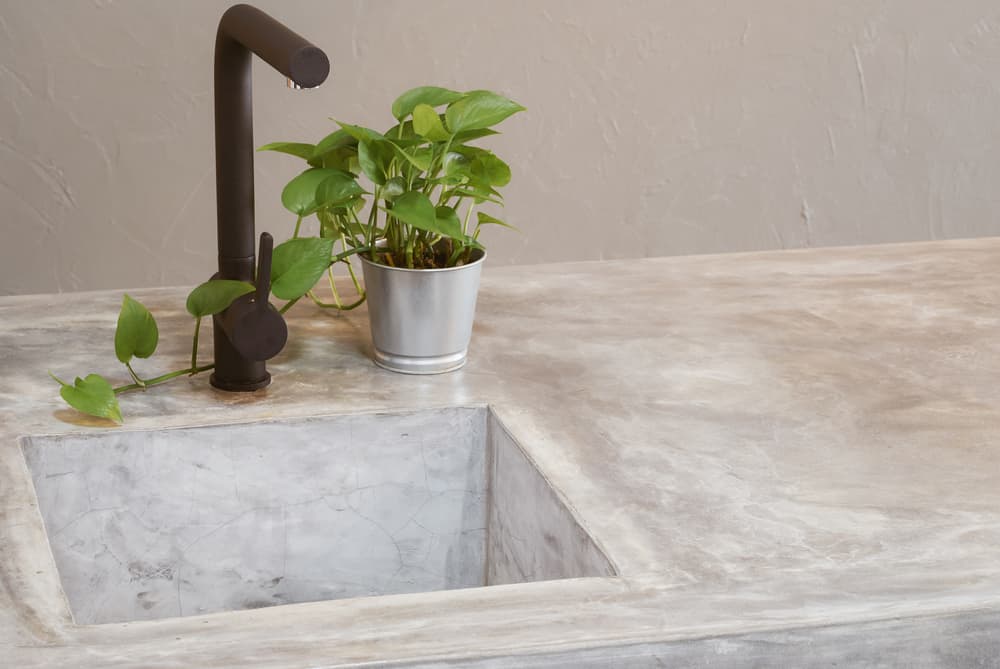
A chunk of sidewalk in my kitchen? Ew!
Don’t fall for that, it’s not true. Concrete countertops are actually very beautiful and, importantly, completely hygienic to have in your kitchen, bathroom and elsewhere in your home.
They’re solid countertops, without seams, that give you an extraordinary chance to customize your kitchen and suit whatever style of décor you’re into. Concrete is a solid, strong material – as strong as stone. Sealed properly, and its more stain-resistant than most stones used to create countertops, like quartz, granite and soapstone.
It’s not rough and coarse either. It can be sanded, ground down and polish to a high sheen! The edges can be left rocky and authentic, or smoothed down into a gentle curve for a softer home décor vibe.
And no, they’re not reused from sidewalks. In fact, most concrete countertops will be poured directly and set in your kitchen! Those that are transported and installed in your kitchen are made from food-safe concrete that’s specifically formulated for use in your home.
They can be very chunky, with low hanging edges that give the appearance that you’ve got a luxurious, thick slab on top… but most are only a few inches thick, just like a stone countertop. They’ll need plenty of support, so before you save up for a concrete countertop make sure you can afford ultra-strong cabinets first!
We particularly recommend concrete countertops for awkwardly shaped kitchens (it can be poured into any shape or dimensions cabinet or island), kitchens in direct sunlight in hot climates (concrete will keep your kitchen deliciously cool), and kitchens that want something utterly unique!
Concrete Countertops: Pros and Cons

We like concrete a lot because the pros far outweigh the cons, in our opinion. But there are cons, so check them out below and carefully consider if they are a deal breaker before you design your kitchen around a concrete countertop!
Pros
- As solid and durable as rock countertops
- A premium material that’s considered a good choice for kitchens by professional chefs and property experts alike
- Can be any size and any shape, with no seams
- It’s incredibly easy to personalize: it can be stamped, stained, molded, dyed and dotted with colors and materials
- Doesn’t transmit heat and will stay cool in the summer. You can place hot pans and trays on it straight from the oven without damaging the concrete
- Very easy to clean, no special equipment is needed
- Non-porous when sealed correctly, so won’t stain easily
Cons
- Extremely heavy, so you may need to reinforce cabinets and even flooring if you’re using a lot of it
- You will need to seal it properly and maintain that top seal to prevent stains and wear
- Stains and acid washes on the surface won’t permeate deep into the concrete so they can wear away off the top layer quickly – keep a note of the wash/stain/color you’re using so you can top it up
- Major cracks and damage cannot be repaired – you’ll need to replace the countertop or live with the damage (you might like it!)
- The price can be equal to high-priced natural granite stone countertops (top-of-the-line)
How to Make Concrete Countertops

You’ve probably seen how concrete is made at some point. Pour the mix with water, turn it, then pour it… right? Actually, there are a few more steps you need to go through. We strongly advise that you get a professional to do it for you, or give you detailed instructions. And once you’ve chosen your concrete mix (tips on what concrete to use for countertops below in our FAQ section), make sure you follow the instructions carefully as they might vary from one supplier to another.
To give you a better idea of the entire process, these are the basic steps to installing a concrete countertop the right way:
- Using long strips of wood, create an outer template that will fit around the countertop you desire.
- Back this template on a sheet of plywood that’s coated in a resin cover, making sure all corners are properly sealed.
- Prepare the concrete mix next to the countertop template, on top of the countertop. Pour it slowly and evenly into the template until it’s 2/3 full.
- Using a sanding orbiter, shake the template so the concrete is an even layer and any air bubbles have risen out the top of the mix.
- Place a reinforced steel mesh on top of the mixture and shake again so the mesh settles into the concrete.
- Top up the template with concrete to the top and level it off.
- You may need to repeat this last step a few times as the concrete settles and needs topping up and smoothing over.
- Leave it to dry and cure for at least 1 week, then ease off the template with a crowbar.
- Sand down sharp edges, etch the surface with muriatic acid, then wash it off with water and leave to dry.
- Mix cement with latex additive and apply smoothly to the surface of the countertop, then let it dry.
- Sand it until it’s smooth, then seal around under the edge.
- Buff the new concrete countertop until it has a lovely shine, then get cooking!
Different Concrete Countertop Finishes
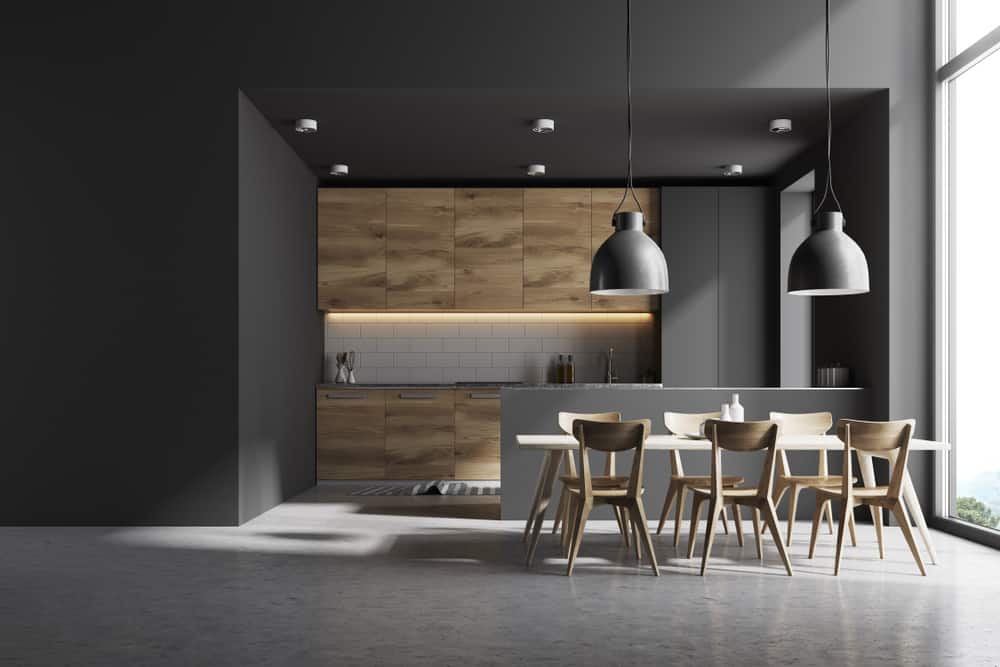
Worried that your concrete countertop will end up looking like the sidewalk? Relax! There are many different finishes that you can use to make your countertop shine. Below we’ve covered a few of the most popular concrete countertop finishes. Pair these with an overall style for your new kitchen carefully.
1. Marbled Concrete Countertops
Marbled stones, like granite, are highly attractive stones used as posh kitchen countertops. But you can recreate this with concrete too!
Our favorite to do is swirl blacks or whites amongst the natural gray color of concrete to create a marbled effect like granite. But you could go colorful too! The image below is of a stone countertop. With dyes, stains and a little patience when pouring and finishing the concrete countertop, you can achieve a similar result.
2. Grained Wood Concrete Countertops
Concrete, even when rough and worn, is still a very sleek, smooth and solid material. So, one way to add some texture to your countertop is with a grain effect. With some skill (we actually recommend you hire someone) you can carve in a wood-type grain into the surface. Or, you can use dyes and stains like with the marble technique to create a countertop that appears textured by is actually smooth and perfect for cooking on.
Grains don’t have to be natural, though. Creating a chipped, rocky edge to the countertop is another very attractive way to finish the edge.
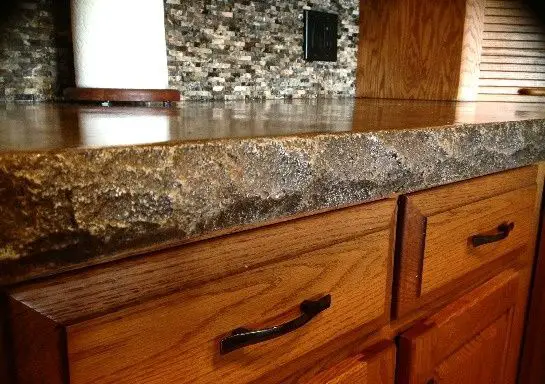
Image credit: Walt Tools
3. Polished Concrete Countertops
Ultra smooth concrete can be almost shimmering in the light, like a pure resin, plastic or stone worktop. A polished concrete countertop might be the most beautiful in our opinion, but it’s also the hardest to maintain.
Not only will the countertop dull with age, but fingerprints, cracks and chips will show very clearly. They’ll show more on pure white and black countertops, so we’d recommend going for a polished marble look or a bright color.
https://i.ytimg.com/vi/INRxLln06f0/maxresdefault.jpg
Image credit: diy room decor
4. Speckled, Flecked and Mock-Quartz Finishes
These are beautiful and actually fairly simple to do. While the other methods of coloring or styling concrete are imposed in the finishing stage, this method adds materials to the concrete mix itself.
Minerals, grit, sand, color dyes, stains, glass fragments and stone chips are added to the concrete mix, so they show all over and throughout the concrete countertop. This has a few advantages. Firstly, it won’t wear off like a top layer. It also will show on the edges of the countertop block. And finally, it’s a lot easier than adding stains and washes after the countertop has set.
We love how many new options this gives you. Try something new and modern, like this countertop.
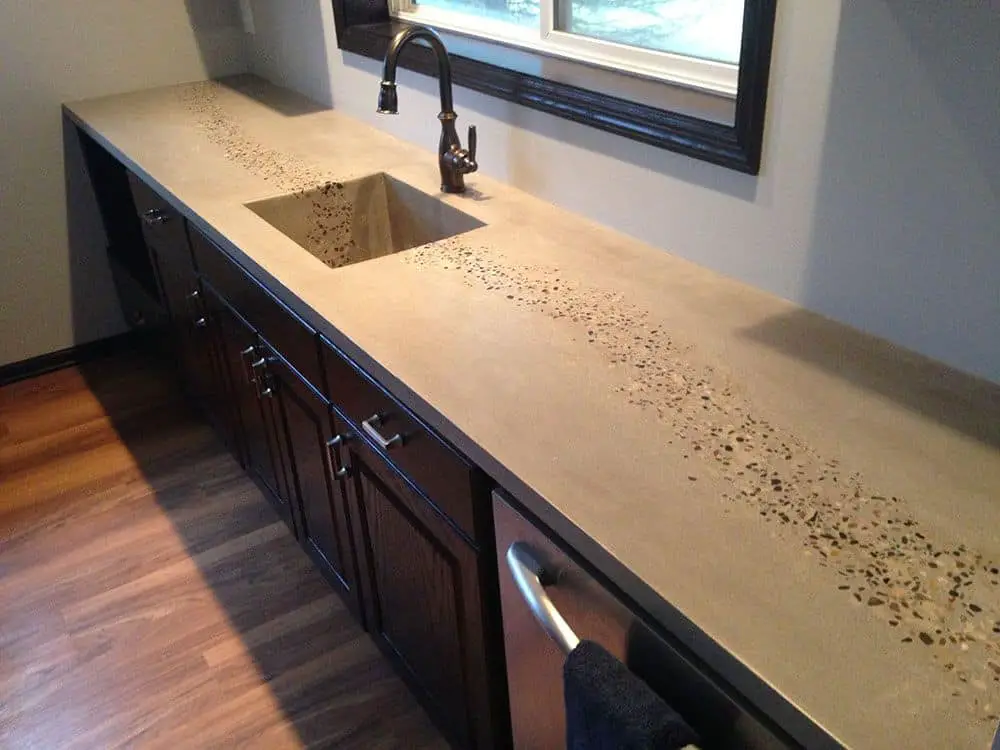
Image credit: iscareyou
Or perhaps you like the allure of a classic stone countertop? You can create a mock quartz countertop like this with minerals and glass.
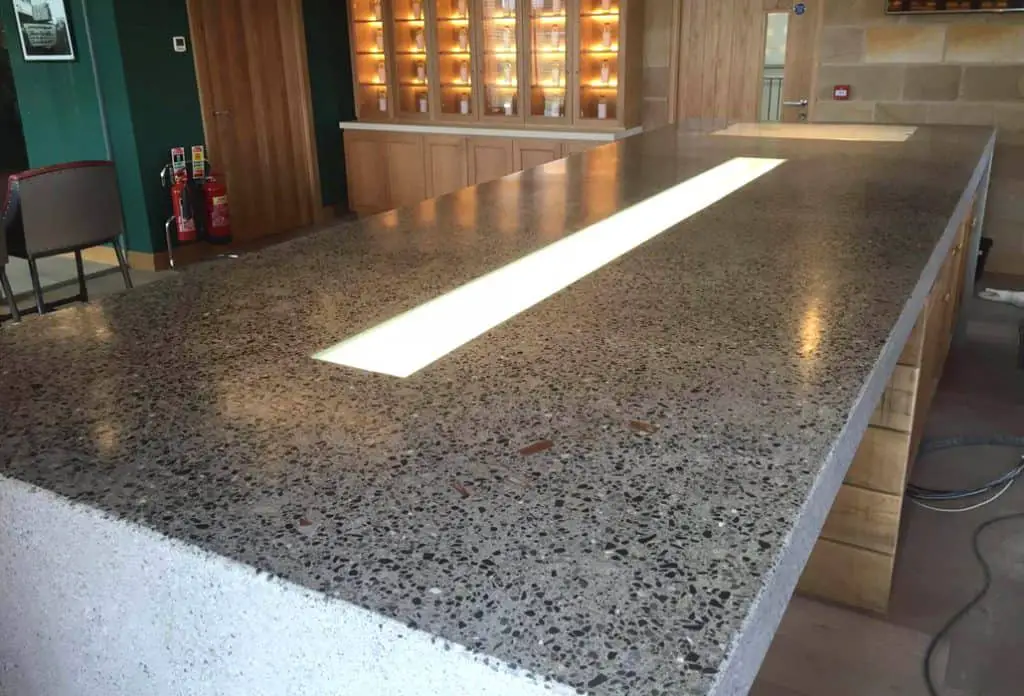
Image credit: P.MAC
The Best Concrete Countertop Kitchen Ideas
If you’re still unsure about whether to go ahead with your concrete countertop, these ideas will sway you! The beautiful thing about concrete compared to stone countertops is that it’s so changeable. It’s a blank slate for you to turn into your own creation.
1. Clean, Clear and Crisp Gray Concrete Countertops
https://i.ytimg.com/vi/jsVKPtc-k2M/maxresdefault.jpg
Image credit: RunmanReCords Design
Look at how the combination of light woods, chrome accents and a pop of color here and there really transforms the dull gray into a light, refreshing silver. The key to this design is actually to keep the concrete matte, and not overly shiny. This isn’t a varnished, polished design but a clean, stripped back kitchen that feels very down to earth and welcoming.
2. Rocky and Eye-Catching Concrete Countertops
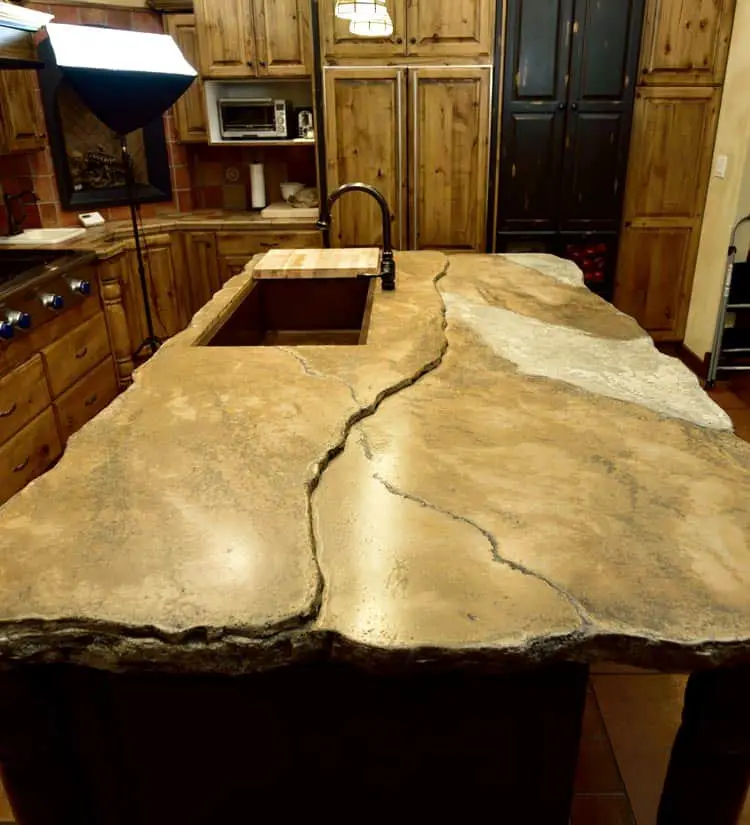
Image credit: Stone Crete Systems
Wow, look at that!
We love this design, although it does take some real skill to create it. You could carve, or get it professional poured into a mold, then stained to give it depth. You could take this type of kitchen countertop in many ways.
You could play up the rustic edges with wooden cabinets and farmhouse style décor… or you could go the other way. Make it industrial. Strip away the natural browns and go for solid grays, metals, and resin. Stainless steel can work well with this. Adding a pop of color (we recommend a vivid red) can add some warmth and give it a modern, minimalist feel too.
3. Something Unique…
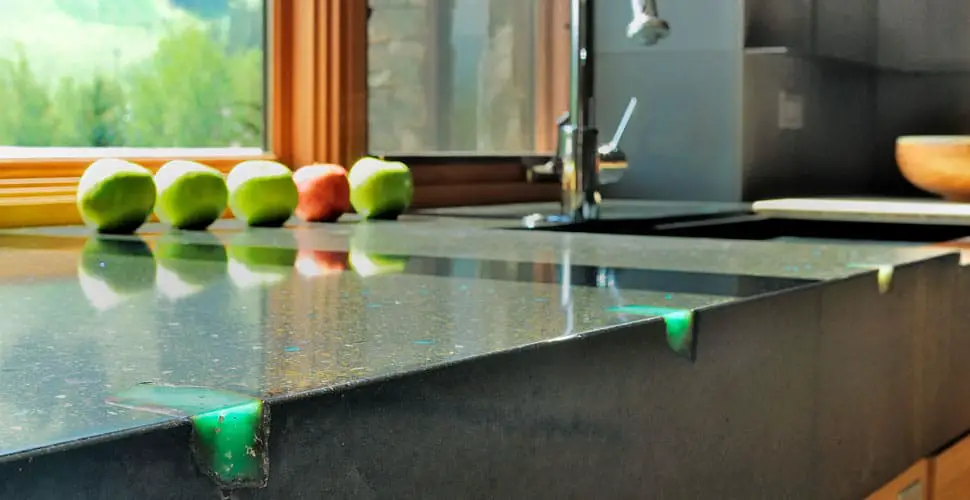
Image credit: Concrete Exchange
This is a very unique design, with a quartz-like finish on the top and elegant green stones embedded in the edge of the concrete.
Concrete isn’t like stone. It doesn’t have natural designs and intricate swirling patterns. But don’t think of that as a bad thing! It’s your chance to put your own design on it.
Natural stones are a lovely idea… but not cheap. So, consider glass (recycled if you’re into making an eco-kitchen), plastic resins, and other metals and stones that will add some character to the otherwise gray concrete.
Top Concrete Countertop FAQs
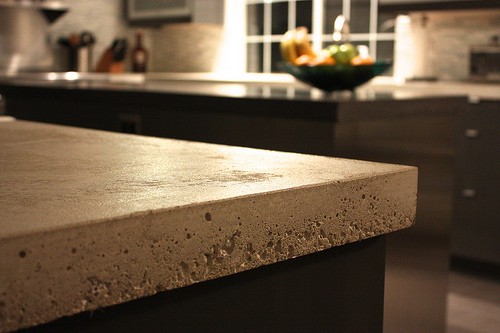
Image credit: Concrete Ideas
As we’ve discovered concrete countertops are beautiful… but do you know how to look after them? Granite and other popular stones need particular cleaners, while stainless steel actually looks better when it’s scratched and worn in!
So, what about concrete? We’ve put together the top questions we come across to give you an idea of the maintenance needed to keep your concrete countertop looking sparkly and new.
Do you find yourself asking…
1. How to Polish Concrete Countertops?
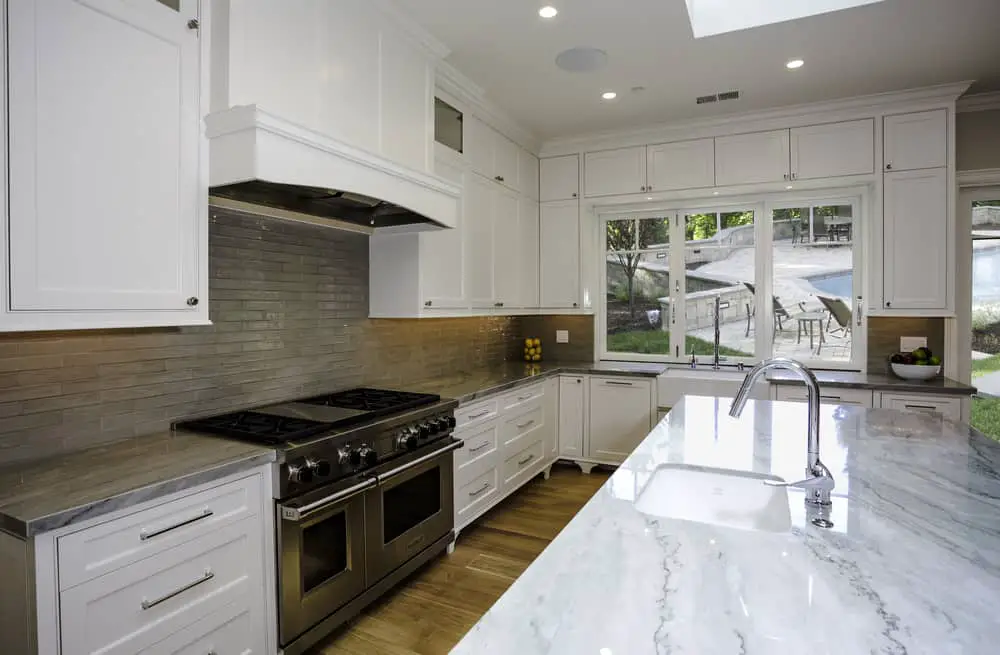
The quickest and most efficient way to polish your new concrete countertop is with a hand-held wet concrete countertop polisher. You’ll need to clean the countertop and apply a slurry to fill any gaps before you polish.
Then, starting with the coarsest setting or sandpaper, go over the surface evenly. Work from the coarsest to the least coarse setting.
Once it’s dried, you’ll need to seal the top of the concrete again – but don’t worry, that shine will remain through!
To keep your countertop looking polish every day, make sure you keep it clean!
It’s worth considering if the rough, worn-in, look of a concrete countertop will fit better with your kitchen. Having shiny or glossy accents will really stand out in comparison to a matte countertop, while large glossy glass or plastic cabinet doors and lighting will make it feel dull.
2. What is The Best Concrete for Countertops?
For countertops, you need a very strong, dense concrete that won’t shrink. It needs to be very rigid and hold its shape – you don’t want it sagging off the sides as it hangs over your counters!
You can’t use the same concrete that would be used for a sidewalk, for example. Instead, the best thing to do is find a concrete mix that has been specially formulated for use as a countertop. This will be food safe, strong and highly durable.
Well-known brands like QUIKRETE have concrete blends with clear instructions so you can confidently take on a DIY concrete countertop project.
3. How to Make Concrete Countertops Look Like Granite?
The best way to make your concrete countertop look like granite is to use a mineral/dye finish that can be applied on top of the countertop and around the sides.
Start by washing the countertop and letting it air dry. Following the instructions for your stain or dye, apply it evenly. You can try a marble design (a beautiful classic!) or a flecked, quartz-like design with minerals. Once dyed, you need to apply a top coat of some sort to protect it. Sand down any rough areas.
Extra tip: buy your dyes, minerals and stains in bulk! These colors won’t penetrate deep into the concrete, so as the thin top layer starts to wear down, the colors will fade. You’ll need to top up the granite look after a while, so it’s a good idea to make sure you have the right product to match the color you want for your kitchen.
4. How to Seal Concrete Countertops?
There are many different concrete sealer brands you can find online, but most will be applied in a similar manner. Check out our quick guide to installing a concrete countertop below to find out how.
When searching for a concrete sealer, it’s best to buy one that’s specifically designed to be used on countertops. If not, make sure it’s food safe, acid resistant and very durable as you’ll be using the countertop every day.
5. How Much Do Concrete Countertops Cost?
Typically, concrete countertops can range from $60 to $140 per square foot. This is approximately the same as stainless steel, or a little higher, for comparison.
When getting quotes, make sure that the full quote includes:
- Material costs
- Installation costs
- Staining/coloring costs
- Sanding, sealing and finishing
- Cleaning up the kitchen and ensuring it’s ready and safe for use
- Warranties and guarantees.
6. How to Stain Concrete Countertops?
Once sealed, concrete is usually highly stain-resistant (find out how to remove stains below, just in case there are some spills) so you need to stain the concrete before or after it’s set but before it’s sealed.
In our brief guide, you’ll need to add your stains and dyes with the last batch of cement and latex additive. Bear in mind that this will only color the top, so save some dye for the sides if required.
You can also use acid stains that react with the top layer of concrete (after it’s set but before it’s sealed), but these can be unpredictable. They can also wear down over time, so you’ll need to re-stain eventually to keep the same color/design.
The final method is to add integral pigments to the concrete mix itself. You can find these concrete dyes online. Too many of these pigments and the color will be very bright, so make sure you follow the instructions!
7. How to Install Concrete Countertops?
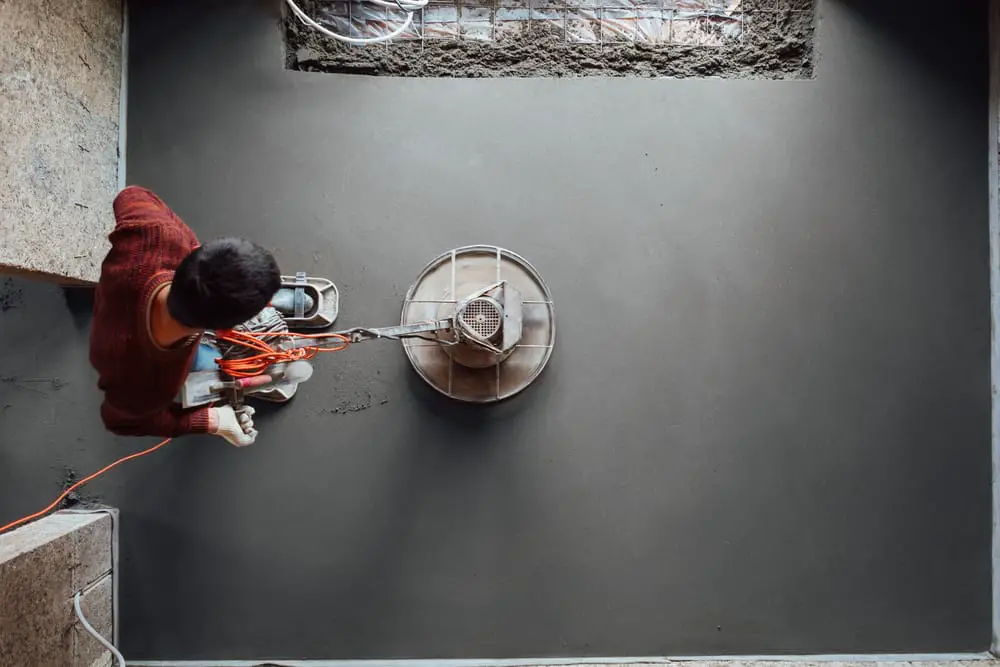
Technically, you don’t install concrete like you would a stone or metal countertop! Instead, the best way to create a concrete countertop is to pour it directly into a mold, so it sets as a solid piece. Trying to move around a large slab of concrete is a recipe of disaster; not only is it extremely heavy and requires specialist equipment but moving it is likely to cause cracks to develop.
However, if you’re dead set on bringing in a concrete slab to create a rustic, industrial style kitchen, follow these tips.
- When moving the countertop yourself, make sure you keep it vertical and standing up on one edge, not laid flat like it’s final position.
- Mark which side is up, and which side is down! The base of the concrete will be reinforced and heavier than the top, designed to hold the weight. If it’s flipped or installed upside down, it will not be able to support the weight of the countertop.
- Create a very sturdy “A” frame that supports the countertop on all sides. Add as much padding as possible with old sheets and blankets.
- If moving multiple slabs, keep them separate rather than wrapping them up within the same supportive frame.
- Rolling the concrete slabs on trolleys is the easiest way to move them. If you’re carrying them around yourself, make sure you have plenty of places you can put the slab down to rest on your journey.
Finally, if you’ve managed to save a few bucks by doing your countertop DIY, you might as well spend that money on professional help moving the countertop. The last thing you want to do is crack or chip your countertop moments before it’s installed.
8. How to Clean Concrete Countertops?
Cleaning stains off concrete countertops is relatively easy and doesn’t require any special cleaning equipment. For general cleaning, you can use dishwashing liquid, a soft cloth and warm water. For stubborn stains, you can apply a more potent cleaner like laundry detergent (pick one that’s designed to remove stains from clothes). Leave it to sit on the counter for a little while before washing off. Make sure all traces of detergent are removed before using the countertop for cooking again.
Related: